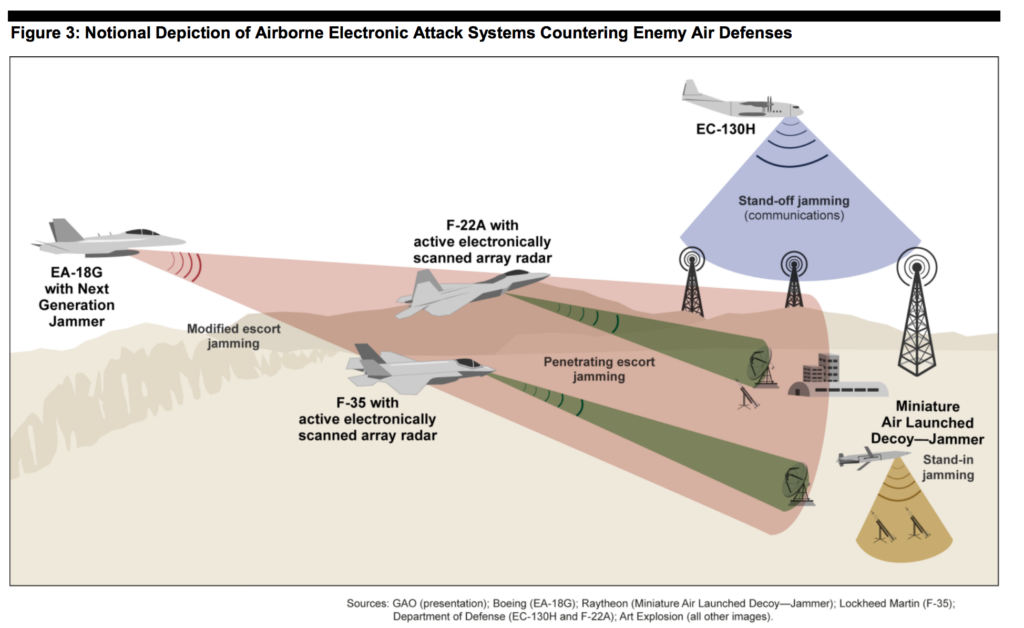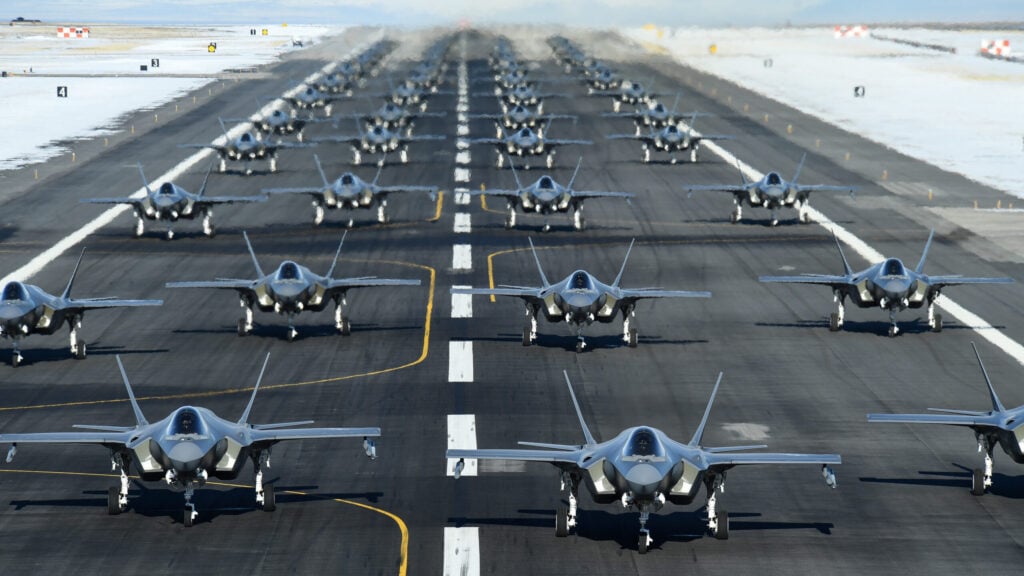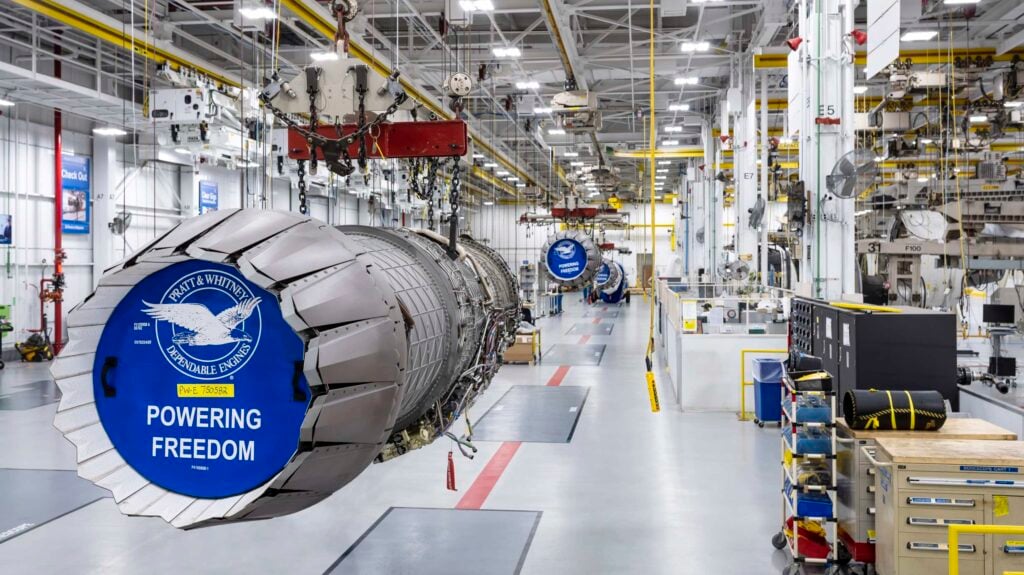WASHINGTON — A $16.5 billion electronics upgrade will increase the F-35’s combat power as much as 10-fold, especially in electronic warfare, according to the Air Force Association’s in-house think-tank, the Mitchell Institute — if Congress keeps the money coming for the struggling program.
What’s on the menu, as detailed in a newly released report from Mitchell, includes a new radar that analysts say is twice as capable, able not just to detect targets but to jam their radars before they can detect incoming US aircraft. There are improved passive sensors, letting the F-35 hone in on enemy emissions without having to emit detectably itself. Another tweak fits one-third more missiles in the same size weapons bay. An upgraded display keeps the pilot from drowning in data. And, to control it all, a new computer using AI software and 25 times the processing power.
RELATED: Lockheed eyes locking down next F-35 production agreement by end of year
Those are just the most important of the almost 80 upgrades to the F-35 stealth fighter that are being packaged together as Technology Refresh 3 (primarily hardware) and Block 4 (primarily the software). But, in the latest complication for the seemingly accursed F-35, TR-3 is already a year behind schedule, while Block 4 is three years behind and $6 billion over budget, with a frustrated program office outright refusing new deliveries from the contractor, aerospace titan Lockheed Martin, until TR-3 finally passes testing.
And, to add one more complication, the complete TR-3/Block 4 package requires more electrical power and more cooling than the F-35’s current engine, the Pratt & Whitney F135, can provide without overstressing the engine and causing costly maintenance problems, the report says. An updated engine could also offer greater range, especially helpful in the vast distances of the Pacific. But the way ahead on engines is obscured by an unusual public feud between engine subcontractor Pratt, advocating an improved F135 called the Engine Core Upgrade (ECU), and prime contractor Lockheed, advocating an all-new Adaptive Engine Transition Program (AETP). The Air Force has said it won’t pursue the AETP for the F-35, and its budget cuts all funding for it, though lawmakers could reverse that.
The Mitchell Institute has stayed studiously neutral on which upgrade path they’d prefer and actually advocates a mix of both: While AETP is more powerful, it can’t fit in the fighter’s jump-jet variant, the F-35B. For the analysts, what’s essential is that some engine upgrade happens.
“It is unquestionable that this jet needs more power, cooling,” said Doug Birkey, the Mitchell Institute’s executive director [PDF], in a Wednesday roundtable with reporters. “It is also clear as day that this jet’s going to be around for decades, so whatever solution is picked has got to be enduring.”
The F-35’s power and cooling are already “radically oversubscribed,” Birkey added. To take full advantage of TR-3/Block 4, “you need ECU or AETP.”
The Pentagon does have a little time to figure all this out, because the approximately 75 upgrades packaged in TR-3/Block 4 won’t all arrive in one big bang, but over several years. Once the basic TR-3 hardware is in place, moreover, each successive installment should be a relatively simple matter of uploading new software, a much quicker process.
“In many ways, the program did itself a disservice with this umbrella term, because people think it’s one thing,” Birkey told reporters. “Block 4 is not one thing: It is a rolling set of capability upgrades that will extend for years. So what we’re talking about here is the first wave… This thing just keeps going.”

While older aircraft like the EA-18G and EC-130H jam enemy systems from a distance, stealthy F-22s and F-35s can slip through air defenses to conduct electronic warfare at close range. (GAO graphic)
‘An Entirely New Jet’?
So what’s the net impact of all these assorted upgrades on combat performance? “This is subjective, but, [it’s an] order of magnitude,” said retired Lt. Gen. David Deptula, dean [PDF] of the Mitchell Institute. “Ten times.”
“TR-3, Block 4, is going to be fundamentally, radically better,” agreed Birkey. “In many ways it’s an entirely new jet in a similar outer moldline.”
How is that possible? Modern military performance is driven more and more by software, not hardware, and software is vastly easier to change. The F-35 is a prime example. “I grew up flying fighters,” says Gen. David Goldfein, then Air Force Chief of Staff, back in 2018, “and I will tell you, when I see the F-35, I don’t see a fighter. I see a computer that happens to fly.”
While a supersonic stealth jet is no joke, the F-35’s physical specs are less impressive than its bigger, older brother the F-22, with no Mach 1.5-plus supercruise or thrust-vectoring agility. Nor can it perform flashy but tactically useless airshow maneuvers like the Russians’ beloved Pugachev Cobra.
However, the F-35 is meant to suck in information from an array of sophisticated sensors, both built-in and off-board; fuse the disparate types of data into a clear picture for the pilot; and then use guided missiles or electronic jamming to disable the enemy from a distance.
Those electronic warfare capabilities are arguably the centerpiece of the Block 4 upgrade, combining the offensive capabilities of the new AN/APG-85 radar sensor/radar jammer with sophisticated sensors to zero in on enemy transmissions, AI algorithms to calculate how best to counter them, and displays to present all these targets, threats, and options intelligibly to the pilot.
“Most of what we need the F-35 to do rests on the Block 4 electronic warfare capabilities,” the chief of Air Combat Command, Gen. Mark Kelly, told reporters in March.
“With TR-3/Block 4, F-35 is probably going to be the best electromagnetic warfare aircraft in our inventory,” said Mark Gunzinger, director of future concepts [PDF] at Mitchell. But the details very quickly get classified, making it even harder to understand the F-35’s intangible capabilities.
Meanwhile Congress is fuming at Block 4 delays and other highly visible difficulties with F-35, including a mission-capable rate, as of March, of only 53 percent, which the program director himself called “unacceptable” [PDF].
But, the Mitchell experts argue, the F-35 is still a vast improvement over the unsteathy and less-computerized aircraft it will replace, such as the famous F-16 among others. And with F-22 production line dismantled, F-35 is the only game in town to replace aging Reagan-era fighters with a stealth aircraft.
Said Gunzinger, “We took a 25-year holiday on modernizing our combat air force — our bombers, our fighters and other things as well — and now it’s come due.”
Air Force awards SNC $13B contract for new ‘Doomsday’ plane
The win is a major victory for the firm in a competition that saw the surprise elimination of aerospace giant Boeing.




























